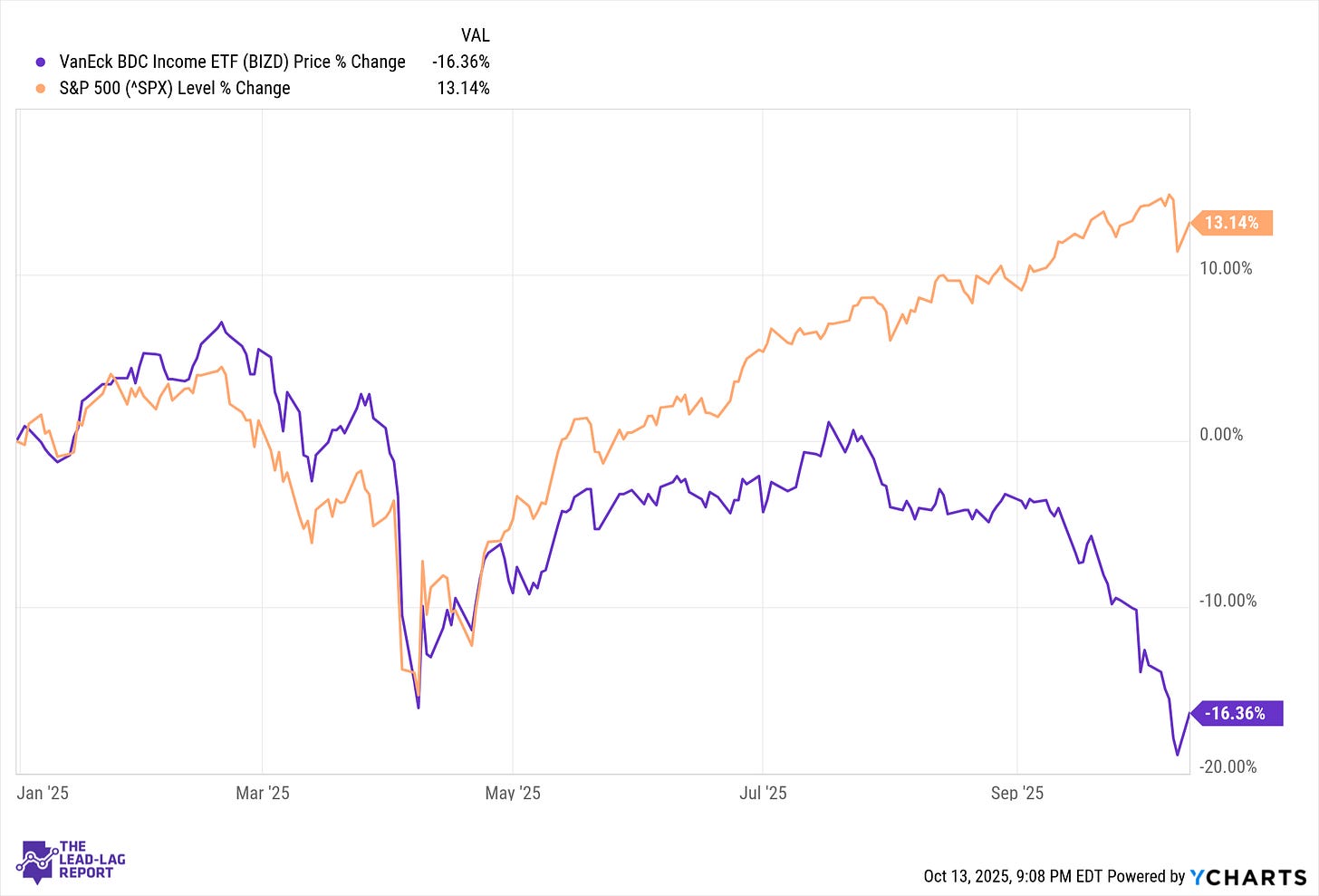The Business Development Company (BDC) sector has had a rough ride in 2025. The VanEck BDC Income ETF (BIZD), a broad proxy for the group, is down 16.36% year-to-date as of early October, while the S&P 500 is up over 13%.¹ Even reliable names like Ares Capital (ARCC), Blue Owl Capital (OBDC), and Blackstone Secured Lending (BXSL) are trading 10–20% below their 2024 highs.² Despite attractive yields — often in the 9–11% range — the market is pricing in deeper credit risk and the possibility of further dividend cuts.
Why the underperformance? BDCs lend to middle-market businesses, often privately owned and thinly capitalized. In a high-rate, slowing-growth environment, defaults rise quickly — and mark-to-market transparency is limited. What was once seen as a stable, floating-rate income play now carries the stigma of embedded risk and illiquidity.
Rising Risks in Private Credit
Elevated rates have exposed cracks in the private credit boom. Many of the loans BDCs made in 2021–22 at tight spreads are now under pressure. Defaults are beginning to rise, especially in sponsor-backed deals with EBITDA addbacks and aggressive leverage.³
Fitch Ratings has flagged deteriorating dividend coverage ratios and warned that “a reduction in benchmark interest rates in 2025 could significantly pressure earnings.”⁴ Analysts expect a median dividend cut of 5–8% if the Fed lowers rates by just 75 basis points.⁵ Several prominent BDCs — including Oaktree and Golub — have already trimmed distributions this year.⁶
This isn’t just a temporary issue. Much of the BDC ecosystem relies on floating-rate income — which looks great in an 8% SOFR world but much less so if front-end rates fall to 5–6%. As borrowing costs remain sticky and credit spreads widen, the margin for error shrinks.
The Case for Selectivity
Despite the caution flags, not all BDCs are equally exposed. A handful of managers have maintained conservative underwriting, avoided overleveraging, and focused on senior-secured, low loan-to-value structures. In fact, the best-run BDCs continue to generate more in net investment income than they pay in dividends — a critical buffer in turbulent markets.
Moreover, floating-rate income is still generous. BIZD’s SEC yield sits near 9.9% as of October, with several top-tier BDCs yielding 10–12% while maintaining solid balance sheets.⁷ That income cushion can compensate for volatility if underlying credit quality holds.
A modestly dovish shift from the Fed may also help. The latest dot plot suggests 50 basis points of cuts by year-end, with policymakers signaling easing is on the table despite persistent inflation.⁸ Lower front-end yields would reduce BDCs’ funding costs and potentially stabilize spreads — especially for firms that rely on secured credit lines.
In short, BDCs with the following traits may offer asymmetric upside: conservative leverage (below 1.2×), high first-lien exposure (70%+), strong dividend coverage, and experienced managers with track records of capital discipline.
Here are five BDCs that meet that bar.
Five Stock Ideas
Ares Capital (ARCC) – Middle Market Giant with Scale Advantage
ARCC is the largest publicly traded BDC, managing a ~$28 billion portfolio focused on sponsor-backed U.S. companies.⁹ With 72% of its portfolio in senior secured debt and net leverage of 1.10x, it maintains one of the most conservative balance sheets among large BDCs.¹⁰ Recent quarters show steady net investment income covering 108% of its dividend.¹¹ For investors seeking size, liquidity, and scale-driven diversification, ARCC is a clear frontrunner.
Keep reading with a 7-day free trial
Subscribe to The Lead-Lag Report to keep reading this post and get 7 days of free access to the full post archives.


